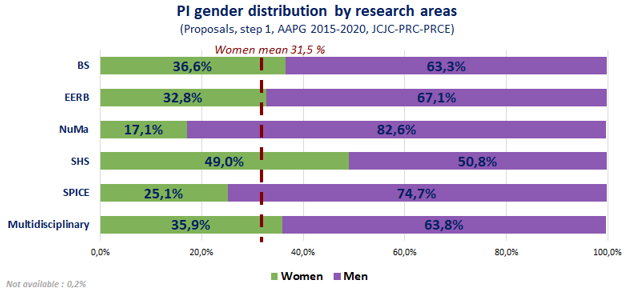Women and men in the Generic Call for Proposals (AAPG): ANR continues and enriches its analyses

These commitments are cross-cutting across all of the missions entrusted to the agency, particularly as part of its selection processes to combat potential gender biases in project evaluation.
To achieve this, several principles and actions are implemented, such as the systematic search for parity in scientific evaluation panels, the training of committee chairs, the introduction of narrative CVs to be provided online when submitting a project, including a tab dedicated to career interruptions, and the analysis of project submission and selection data.
The production and publication of recurrent analyses of these data will serve to identify possible gender biases in the evaluation and also to highlight changes in women's and men's practices in terms of responding to ANR calls for proposals, and reflects the social gender issues also at work in the field of higher education and research (HER).
The analyses produced and presented here focus on the Generic Call for Proposals (AAPG) over the 2015 to 2020 period. They are in line with those published in 2019. They offer an update of the data, incorporating the 2019 and 2020 editions and are enriched with new indicators.
More and more women are submitting projects

While the proportion of projects led by women corresponds to the proportion of women in the HER, it increased by 5 points between 2015 and 2020 (2,021 projects submitted in 2015 vs. 2,257 projects in 2020). The number of projects led by men on the other hand, is constantly decreasing (4,872 projects submitted in 2015 vs. 4,313 in 2020).
These sexually differentiated trends are part of a movement engaged in recent years in the fight against inequalities reflected in the public service transformation act (2019) making the implementation of an equality action plan in institutions compulsory according to the reference document describing the compulsory and priority fields of action.
These trends could therefore be the sign of a reorganisation of the division of labour between women and men within laboratories with, however, marked differences according to subject area1.
Strong disparities according to subject area
The distribution of projects according to whether they are led by women or by men in each major scientific field is generally a reflection of the proportionality of women and men within these fields at the national level2, with some disparities.
It is in the human and social sciences that the proportion of projects led by women is the highest, in line with the proportion of women in this scientific field. The proportion of projects led by women in Biology-Health on the other hand (36.6%), is not representative of their presence in their field where they are in the large majority (over 60%)3.

Ever more "young female researchers"
The increase in projects led by women is found in each of the AAPG instruments, while remaining higher in the Young Researchers (JCJC) instrument (+6 points) to which women are potentially eligible for longer than men with regard to the exemptions granted when they have children.

That women preferentially invest in this instrument can also testify to the fact that they are focusing on the accumulation of proofs of their skills4 and obtaining a higher status in the academic hierarchy before allowing themselves to submit larger-scale projects such as PRC or PRCE type collaborative projects.
The age of female project coordinators is significantly different from that of male coordinators

Among the funded JCJC projects, the age of male and female coordinators differs in that the men are younger than the women: 40% of them are under 34, compared to only 34% of women.
This reflects the higher age at which women reach a statutory position. Indeed, they face greater difficulties in accessing academic positions (6 to 8 years after the thesis compared to 3 to 4 years for men) and mostly occupy the most precarious jobs (post-doctorates, fixed-term research contracts, contract work) which do not allow them to be eligible for calls for projects as coordinators5.
This also reflects the impact of maternity hospitals on professional activity, which potentially delays the response to calls for projects by a few years.
As a result, women are coordinators of collaborative PRC and PRCE projects at an older age than men. They are particularly highly represented in the 45-49 age group, the very one where the presence of men is starting to decrease.
References:
1 Catherine Marry, « Le plafond de verre dans le monde académique : l’exemple de la biologie », Idées économiques et sociales, n°153, 2008 ; Alain Chenu & Olivier Martin, « Le plafond de verre chez les enseignants-chercheurs en sociologie et démographie », Travail, Genre et Sociétés, 2016.
2 https://www.vie-publique.fr/sites/default/files/rapport/pdf/276854.pdf
3 Des analyses supplémentaires sont nécessaires afin de comprendre la nature des écarts par rapport aux données nationales.
4 Rebecca Rogers & Pascale Molinier (ss dir.), Les femmes dans le monde académique. Perspectives comparatives, PUR, 2016.
Further reading:
Téléchargez l'analyse « Femmes et hommes de science dans l’AAPG, de 2015 à 2020 »
ANR's commitments for gender equality and gender mainstreaming
ANR rolls out an action plan for gender equality and gender mainstreaming
Men - women analysis in the AAPG: interview with Laurence Guyard, Gender referent at ANR


